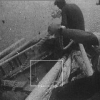Free Online Productivity Tools
i2Speak
i2Symbol
i2OCR
iTex2Img
iWeb2Print
iWeb2Shot
i2Type
iPdf2Split
iPdf2Merge
i2Bopomofo
i2Arabic
i2Style
i2Image
i2PDF
iLatex2Rtf
Sci2ools
79
Voted
ICIP
2002
IEEE
2002
IEEE
A spatiotemporal image sequence restoration algorithm
Temporal restoration of image sequences may fail because of erroneously estimated motion. Motion estimation failures may occur for several reasons: complicated motion, severe artefacts, or a combination of both. We present here an algorithm that tries to overcome at least the problems related to the severe artefacts. It consists of a spatial restoration, which is supposed to recover the general image structure within the missing areas, followed by a temporal restoration. First performing spatial restoration has the advantage that the the motion estimation during temporal restoration can rely on the spatially restored frames. The efficiency of the spatial restoration scheme is demonstrated for both artificial and real life examples. Restoration results when using only temporal restoration are presented for the real life sequences. Finally, we compare both restoration methods with results of the proposed spatiotemporal algorithm which shows its superior behaviour.
ICIP 2002 | Image Processing | Restoration Methods | Spatial Restoration Scheme | Temporal Restoration |
Related Content
| Added | 24 Oct 2009 |
| Updated | 27 Oct 2009 |
| Type | Conference |
| Year | 2002 |
| Where | ICIP |
| Authors | Andrei Rares, Marcel J. T. Reinders, Reginald L. Lagendijk, Jan Biemond |
Comments (0)

